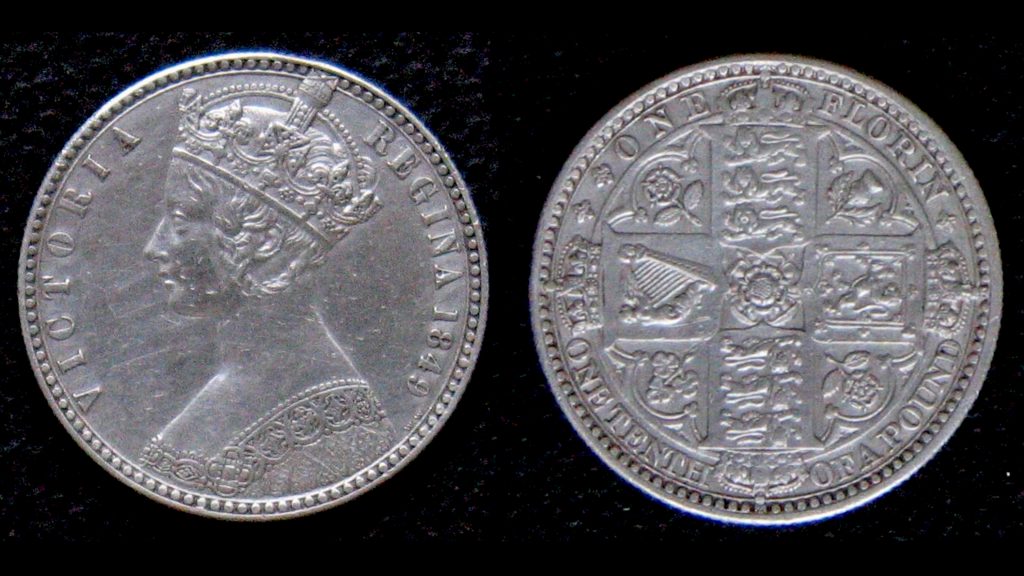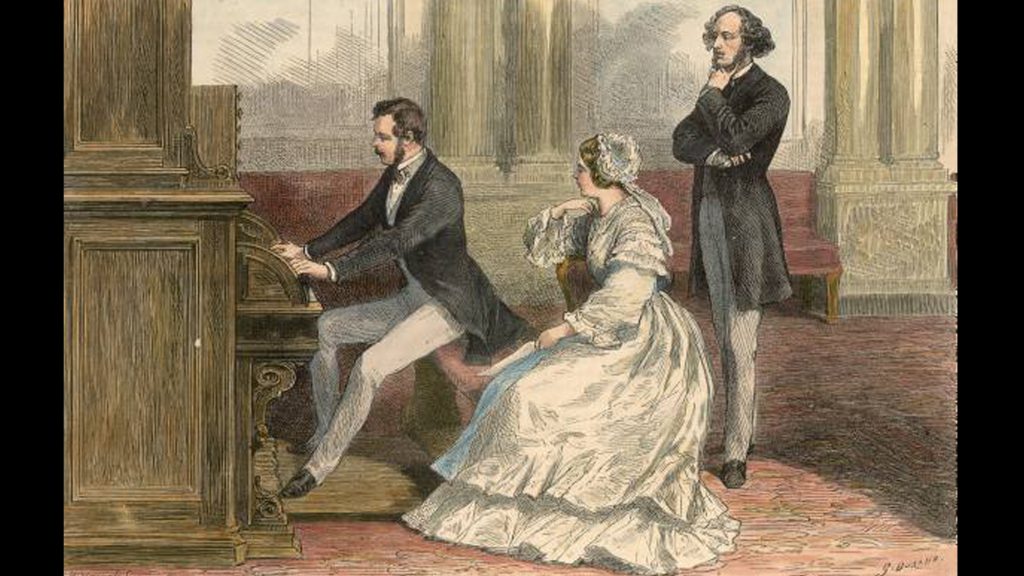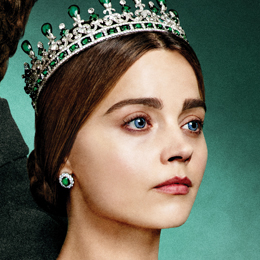History in Images: Victoria Episode 6
A controversial coin, a christening, and a sumptuous costume ball are all part of Victoria Episode 6. See actual historical images, and learn some of the real history behind the stories in this week’s episode.
- 1.
The Godless Florin


The 1849 Florin, known as the Godless Florin; the obverse was designed by the Chief Engraver of the Royal Mint, William Wyon, while the reverse was designed by William Dyce.
In Episode 6, Victoria and Albert oversee the introduction of a new “decimal” coin into British currency.
By 1849, Europe had been using the decimal system for half a century. Britain, on the other hand, did not decimalize until February 15, 1971. From the 1600s until then, the British pound was equal to 240 pence. The value of the florin, issued in 1849, was twenty-four pence, or two shillings (a shilling being twelve pence). At one-tenth of a pound, the florin was considered an experiment in decimalization–an experiment that didn’t amount to much for more than a century.
The first florins issued showed a young Queen Victoria wearing a crown; it was the first time in more than 200 years that a coin depicted a monarch with a crown. The omission of “Dei Gratia” (By the Grace of God), which customarily accompanied the inscription VICTORIA REGINA, earned the coin its share of criticism, along with the nickname “The Godless Florin.” The reverse side of the coin showed the shields of the United Kingdom arranged in a cross, as well as the floral insignias of England, Ireland, Scotland and Wales.
- 2.
Victoria and Albert, The Musicians


Engraving of Prince Albert performing on his organ in the Old Library in Buckingham Palace in the presence of Queen Victoria and Felix Mendelssohn in 1842
Albert and Victoria perform a beautiful duet on the piano in Episode 6, one of many references to the royal couple’s musical abilities.
There’s no question Victoria and Albert were both accomplished musicians who enjoyed playing, singing, and listening to music. Albert had been composing songs and choral pieces from a young age; if it weren’t for his duties as a member of royalty, composing might likely have been his calling. In turn, Victoria sang and played the piano with natural talent and skill.
This shared passion undoubtedly played a role in their budding romance. The day after proposing to Albert, the smitten queen wrote in her journal, “…he sang to me some of his own compositions, which are beautiful, and he has a very fine voice. I also sang for him…”
During their marriage, Victoria and Albert played music together frequently; they especially enjoyed duets, or playing the piano while the other sang. The royal residences–Balmoral, Buckingham Palace, Osborne House, even the Royal Yacht–all had pianos, and Victoria and Albert packed ample sheet music whenever they traveled.
Great patrons of the arts, whether it be music, dance, theatre or opera, the royal couple patronized on average a performance a week. Victoria and Albert often hosted composers at the palace, including the German composer Felix Mendelssohn, whose music Albert introduced to Victoria, and who became a favorite of the queen. It’s said that when she met the composer, in June 1842, she was well-and-truly star-struck.
Her journal for that day reads: “After dinner came Mendelssohn, whose acquaintance I was so anxious to make…he asked us to give him a theme upon which he could improvise. We gave him 2, ‘Rule Britannia’, & the Austrian National Anthem. He began immediately & really I have never heard anything so beautiful, the way in which he blended them both together & changed over from one to the other, was quite wonderful as well as the exquisite harmony & feeling he puts into the variations, & the powerful rich chords, & modulations, which reminded me of all his beautiful compositions.”
- 3.
The 'Powdered Ball'


left: Queen Victoria in 18th century court dress at her Georgian Ball, 1845 | right: Haghe Louis – the Ballroom Buckingham Palace 17 June 1856
Episode 6 features a magnificent Georgian-themed ball hosted by Victoria and Albert at Buckingham Palace.
Victoria and Albert’s costume balls were highly anticipated, lavish affairs. Though only the most distinguished members of society received invitations, the public could count on the papers to expound on the details—who wore what, which notable guests were in attendance, and with whom they arrived.
Victoria and Albert hosted several of these balls, or bal costumés, at the palace. On May 10, 1845, it was a Georgian themed affair, heavy on the white wigs and powdered faces. It came to be called the bal poudré, or powdered ball. Queen Victoria, who greatly enjoyed dancing, is said to have executed a flawless minuet that night. She also loved to host fancy balls for her children’s birthdays, and it was a given that all her children were taught to dance.
In 1842, the Plantagenet-themed ball that Victoria put on to help the Spitalfields silk industry was such a success that the queen commissioned the construction of a new ballroom at Buckingham Palace. With an extravagant forty-five thousand pound price tag, it was a huge and splendid room, equipped with gas lights and a recessed platform supporting two gold thrones at one end. The first ball held in this room was in 1856.
- 4.
A Royal Tradition: The Honiton Gown


left: Queen Victoria holds her grandson, the future King Edward VIII, on his christening day, July 16, 1894| middle: The Christening of Princess Elizabeth in 1926 | right: Princess Diana holds Prince Harry, December 1984, after his christening
In Victoria Episode 6, we see the christening of Victoria and Albert’s seventh child, Arthur William Patrick Albert.
Prince Arthur wears an intricate lace christening gown, the same one worn by his older siblings at each of their christenings. Commissioned by Victoria in 1840, after the birth of her first child Vicky, the dress was crafted with Honiton lace and lined with Spitalfields silk. Janet Sutherland, the Scottish coal miner’s daughter who embroidered the dress, fashioned it after Victoria’s wedding gown because Princess Vicky’s christening was held on February 10, 1841— Victoria and Albert’s first wedding anniversary.
The dress was worn at the christenings of sixty-two of Victoria’s descendants, and is a British royal tradition that continues today. In 2004, recognizing the fragility of the gown’s condition, Elizabeth II commissioned a replica of the gown to be handmade. That same year, the original dress was worn for the last time by Lady Louise Windsor, the first daughter of Prince Edward, Earl of Wessex and Sophie, Countess of Wessex. The reproduction is still in use has been worn for the christening of the next generation of royals: Prince George, Princess Charlotte, and Prince Louis, the children of Prince William, Duke of Cambridge, and Catherine, Duchess of Cambridge.




















